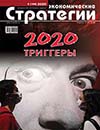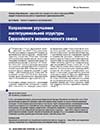Towards an Enhanced Institutional Structure of the Eurasian Economic Union
DOI: 10.33917/es-2.168.2020.102-111
This article considers how to enhance the institutional structure of the Eurasian Economic Union (EAEU) in order to enable timely decision-making and implementation of governance decisions in the interests of Eurasian integration deepening. We compare the governance structures of the EAEU and the European Union (EU) using the author’s technique and through the lens of theories of neofunctionalism and intergovernmentalism elaborated with respect to the EU. We propose to determine a major driver of the integration process at this stage (the College of the Eurasian Economic Commission or the EAEU member states), to reduce the number of decision-making bodies within the current institutional structure of the EAEU, and to divide clearly authority and competence of remaining bodies to exclude legal controversies in the EAEU
References:
|
1. Zadorin I.V., Almakaeva A.M., Babich N.S., et al. Integratsionnyi barometr EABR – 2014 [Integration Barometer – 2014]. Moscow, 2014, 126 p. 2. Glaz’ev S.Yu. Evraziiskii soyuz: rasshirenie rubezhei [The Eurasian Union: Extending the Borders]. Nauchnye trudy Vol’nogo ekonomicheskogo obshchestva Rossii, 2016, no 5, pp. 99–106. 3. Glaz’ev S.Yu. Postroit’ konkurentosposobnyi ekonomicheskii soyuz [To build a Competitive Economic Union]. Evraziiskaya integratsiya: ekonomika, pravo, politika, 2017, no 1(21), pp. 5–7. 4. Doklad o realizatsii osnovnykh napravlenii integratsii v ramkakh Evraziiskogo ekonomicheskogo soyuza [Report on Realisation of Main Integration Directions within the Eurasian Economic Union]. Evraziiskaya ekonomicheskaya komissiya. Moscow, 2018, 154 p. 5. Pilipenko I.V. Evraziiskii ekonomicheskii soyuz: quo vadis? [The Eurasian Economic Union: Quo Vadis?]. Ekonomika i upravlenie: problemy, resheniya, 2019, no 1, pp. 4–44. 6. Ageev A.I., Loginov E.L., Bortalevich S.I. Bol’shoe evraziiskoe partnerstvo: proekt, vstrechnyi Transtikhookeanskomu partnerstvu [Big Eurasian Partnership: Project, Counter to Trans-Pacific Partnership]. Ekonomicheskie strategii, 2016, no 6(140), pp. 20–31. 7. Glaz’ev S.Yu. Kontseptual’nye predlozheniya po prakticheskoi realizatsii idei Bol’shogo evraziiskogo partnerstva [Conceptual Proposals for Practical Implementation of the Big Eurasian Partnership Idea]. Ekonomicheskie strategii, 2019, no 1(159), pp. 6–17. 8. Balassa B. The Theory of Economic Integration. Homewood. IL: Richard D. Irwin, Inc., 1961. 308 p. 9. Ageev A.I., Loginov E.L., Raikov A.N. Formirovanie obshchego rynka nefti i nefteproduktov EAES: fundament soyuznogo ostrovka stabil’nosti v bushuyushchem mirovom okeane global’nykh spekulyatsii [Formation of the Common EAEU Market of Oil and Oil products: the Basis of the Union Stability Island in a Stormy World Ocean of Global Speculations]. Ekonomicheskie strategii, 2015, no 5–6, pp. 8–21. 10. Ageev A.I., Loginov E.L. Institutsional’nye mekhanizmy snizheniya mul’tifaktornykh riskov dlya valyutno-finansovoi sistemy Rossii i EAES v usloviyakh nelineinoi ekonomicheskoi dinamiki [Institutional Mechanisms of Decreasing Multifactor Risks for the Monetary Financial System of Russia and EAEU under Non-Linear Economic Dynamics]. Moscow, Institut ekonomicheskikh strategii, 2017, 104 p. 11. Alekseenkova E.S. EAES k 2025 g.: prioritety i ozhidaniya gosudarstv-chlenov [EAEU by 2025: Priorities and Expectations of Member States]. Perspektivy razvitiya proekta EAES k 2025 godu. Rabochaya tetrad’. Spetsvypusk-2017. Moscow, NP RSMD, 2017, 92 p. 12. Butorina O.V., Zakharov A.V. O nauchnoi osnove Evraziiskogo ekonomicheskogo soyuza [About the Academic Foundations of the Eurasian Economic Union]. Evraziiskaya ekonomicheskaya integratsiya, 2015, no 2, pp. 52–68. 13. Ushkalova D.I. K voprosu o primenimosti sushchestvuyushchikh teorii ekonomicheskoi integratsii k vzaimodeistviyu Rossii so stranami “poyasa sosedstva” [To the Issue of Applicability of Existing Economic Integration Theories to the Interaction of Russia with “Neighborhood Belt” Countries]. Vestnik Instituta ekonomiki Rossiiskoi akademii nauk, 2013, no 5, pp. 150–160. 14. Golovnin M.Yu., Zakharov A.V., Ushkalova D.I. Ekonomicheskaya integratsiya: uroki dlya postsovetskogo prostranstva [Economic Integration: Lessons for the Post-Soviet Space]. Mirovaya ekonomika i mezhdunarodnye otnosheniya, 2016, no 4, pp. 61–69. 15. Pilipenko I.V. Vliyanie Evraziiskoi integratsii na institutsional’nuyu strukturu ekonomiki Rossii [The Impact of Eurasian Integration on the Institutional Structure of the Economy of Russia]. Ekonomika i upravlenie: problemy, resheniya, 2019, no 2, pp. 3–45. 16. Perekhod k rynochnoi ekonomike i strukturnye reformy v gosudarstvakh — chlenakh Evraziiskogo ekonomicheskogo soyuza [The Transition to a Market Economy and Structural Reforms in the Eurasian Economic Union Member States]. Pod red. I.V. Pilipenko. Saint Petersburg, Naukoemkie tekhnologii, 2019, 976 p. 17. Yumashev Yu.M. Evropeiskaya ideya i ee razvitie ot “khristianskoi respubliki” do Evropeiskogo soyuza [The European Idea and its Evolution from a “Christian Republic” to the European Union]. Trudy Instituta gosudarstva i prava Rossiiskoi akademii nauk, 2015, no 3, pp. 5–46. 18. Strezhneva M.V. Teorii evropeiskoi integratsii [Theories of European Integration]. Vestnik Moskovskogo universiteta. Seriya 25. Mezhdunarodnye otnosheniya i mirovaya politika, 2009, no 1, pp. 28–45. 19. Kocheva E.E. Neofunktsionalizm i material’naya logika v teorii evropeiskoi integratsii Va’’tera Khal’shteina [Neofunctionalism and Material Logic in the Theory of European Integration of Walter Hallstein]. Vestnik Tomskogo gosudarstvennogo universiteta. Filosofiya. Sotsiologiya. Politologiya, 2011, no 3(15), pp. 131–137. 20. Lantsov S.A. Teoreticheskie kontseptsii mezhdunarodnoi integratsii i perspektivy integratsionnykh protsessov na postsovetskom prostranstve [Theoretical Concepts of International Integration and Perspectives of Integration Processes in the Post-Soviet Space]. Vestnik Sankt-Peterburgskogo universiteta. Seriya 6. Filosofiya. Kul’turologiya. Politologiya. Pravo. Mezhdunarodnye otnosheniya, 2013, no 2, pp. 65–74. 21. Arbatova N.K. Postkrizisnye modeli evropeiskoi integratsii [Postcrisis Models of European Integration]. Mirovaya ekonomika i mezhdunarodnye otnosheniya, 2014, no 11, pp. 21–26. 22. Mansurov T.A. Metodologicheskie i institutsional’nye osnovy ekonomicheskoi integratsii stran EvrAzES [Methodological and Institutional Foundations of Economic Integration of the EurAsEC countries]: diss. … d-ra ekon. nauk: 08.00.14 / Mansurov Tair Aimukhametovich. Moscow, 2012. 435 p. 23. Kondrat’eva N.B. Evraziiskii ekonomicheskii soyuz: dostizheniya i perspektivy [The Eurasian Economic Union: Achievements and Perspectives]. Mirovaya ekonomika i mezhdunarodnye otnosheniya, 2016, no 6, pp. 15–23. 24. Afontsev S.A. Integratsionnye dilemmy Edinogo ekonomicheskogo prostranstva [Integration Dilemmas of the Single Economic Space]. Vestnik MGIMOUniversiteta, 2012, no 6(27), pp. 117–121. 25. Spinelli A., Rossi E. The Manifesto of Ventotene (1941). Ventotene: The Altiero Spinelli Institute for Federalist Studies, 1941, pp. 75–96, available at: https://www.cvce.eu/content/publication/1997/10/13/316aa96c-e7ff-4b9e-b43a-958e96afbecc/publishable_en.pdf. 26. Deutsch K.W. The nerves of the government: models of political communication and control. New York: Free Press, 1963, 316 p. 27. Marks G. Structural Policy and Multilevel Governance in the EC. The State of the European Community / Edited by A. Cafruny and G. Rosenthal. Boulder, CO: Lynne Rienner, 1993, pp. 391–411. 28. Mitrany D. A Working Peace System. An Argument for the Functional Development of International Organization. New York, Toronto, Bombay, Melbourne, Cape Town: Oxford University Press, 1943, 54 p. 29. Haas E.B. The Uniting of Europe. Political, Social, and Economic Forces. 1950–1957. Notre Dame: University of Notre Dame Press, 1958, 552 p. 30. Lindberg L.N. The Political Dynamics of European Economic Integration. Stanford University Press, 1963, 367 p. 31. Hallstein W. Der unvollendete Bundesstaat. Europäische Erfahrungen und Erkenntnisse. Düsseldorf, Vienna: Econ-Verlag, 1969. 283 p. 32. Hoffmann S. Obstinate or Obsolete? The Fate of the Nation-State and the Case of Western Europe. Daedalus, vol. 95, no 3, Tradition and Change (Summer, 1966), pp. 862–891. 33. Moravcsik A. Preferences and Power in the European Community: A Liberal Intergovernmentalist Approach. Journal of Common Market Studies, vol. 31, is. 4. 1993, December, pp. 473–524. 34. Likhachev V.N. Integratsiya i zakon. EAES nuzhna normativnaya komponenta [Integration and Law. The EAEU Needs a Normative Component]. Rossiiskaya gazeta, 2014, December, 24, available at: https://rg.ru/2014/12/23/lihachev-site.html. 35. Regulations, Directives and other acts. EU Law, An official website of the European Union, available at: https://europa.eu/european-union/eu-law/legalacts_en. 36. Bail’dinov E.T. Dogovor o Evraziiskom ekonomicheskom soyuze: kak opravdat’ nadezhdy? [The Treaty on the Eurasian Economic Union: How to Meet Expectations?]. Obshchestvo i ekonomika, 2014, no 9, pp. 5–21. 37. Dogovor o Evraziiskom ekonomicheskom soyuze (podpisan v g. Astane 29 maya 2014 g.) (v red. ot 15 marta 2018 g.). [Treaty on the Eurasian Economic Union. (Signed in Astana 29.05.2014) (amendments as of 15.03.2018)], available at: http://www.consultant.ru/document/cons_doc_LAW_163855/3d7cf1fc8ba8f53c26f38638d9553751efeac7f1/. 38. Consolidated Version of the Treaty on European Union. Official Journal of the European Union, 2012, October, 26, pp. c326/13-c326/45. 39. Comments on the Council’s Rules of Procedure. European Council’s and Council’s Rules of Procedure. General Secretariat of the Council, Brussel: EU, 2016, 117 p. 40. Osnovnye napravleniya ekonomicheskogo razvitiya EAES do 2030 goda [Main Directions of Economic Development of the EAEU till 2030]. Evraziiskaya ekonomicheskaya komissiya, Moscow, EEK, 2015, 69 p. 41. Materialy Plenarnogo zasedaniya XIV mezhdunarodnoi konferentsii “Evraziiskaya ekonomicheskaya integratsiya” [Materials of the Plenary Session of the 14th International Conference “Eurasian Economic Integration”]. Evraziiskii bank razvitiya. Moscow, 2019, November, 29, available at: https://eabr.org/press/conference/xiv-mezhdunarodnoy-konferentsii-evraziyskaya-ekonomicheskaya-integratsiya/#tab-2 |



